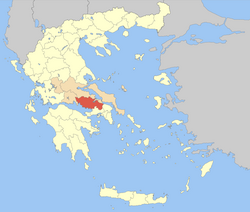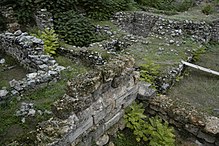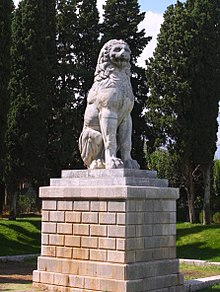Boeotia
Boeotia (/biˈoʊʃ(i)ə/ bee-OH-sh(ee-)ə), sometimes Latinized as Boiotia or Beotia (Greek: Βοιωτία; modern: Viotía; ancient: Boiōtía), is one of the regional units of Greece.Traditionally, the Boeotians are said to have originally occupied Thessaly, the largest fertile plain in Greece, and to have been dispossessed by the north-western Thessalians two generations after the Fall of Troy (1200 BC).[8][9] Although they included great men such as Pindar, Hesiod, Epaminondas, Pelopidas, and Plutarch, the Boeotian people were portrayed as proverbially dull by the Athenians (cf.Boeotia had significant political importance, owing to its position on the north shore of the Gulf of Corinth, the strategic strength of its frontiers, and the ease of communication within its extensive area.In historical times, the leading city of Boeotia was Thebes, whose central position and military strength made it a suitable capital;[12] other major towns were Orchomenus, Plataea, and Thespiae.[12] While the Boeotians, unlike the Arcadians, generally acted as a united whole against foreign enemies, the constant struggle between the cities was a serious check on the nation's development.The Works and Days by Hesiod is often used by economists and historians alike to provide invaluable evidence for the Boetian economic system and its developments in the Homeric Age.[13] According to myth, the Boeotians (Ancient Greek: Βοιώτιοι, romanized: Boiotioi) lived in Thessaly, especially in the area around Arne, though some may have gone to the Pagasitic Gulf before migrating to the land later termed Boeotia.The presence in Classical times in Boeotia of cults and place-names of Thessalian origin, such as Itonia and Itonian Athena, Homole and Homoloian Zeus, Alalcomenae, Corseia and Pharae, confirm for most scholars the merits of these traditions.The second tradition gives Chaeronea as the first place attacked, while the first says that Coronea and Orchomenus were captured virtually simultaneously and then the sanctuary of Itonian Athena was founded.It is clear that both traditions envisaged the Boiotoi as following a well-known invasion route from Thessaly, the one via Thermopylae and Hyampolis to Chaeronea, where the invaders would be poised to attack both Orchomenus and Coronea.In consequence, for a time, the presidency of the Boeotian League was taken from Thebes, but in 457 BC the Spartans reinstated that city as a bulwark against Athenian aggression after the Battle of Tanagra.Athens retaliated with a sudden advance upon Boeotia, and after the victory at the Battle of Oenophyta took control of the whole country, taking down the wall the Spartans had built.[15] For ten years the land remained under Athenian control, which was exercised through the newly installed democracies; but in 447 BC the people revolted, and after a victory at the Battle of Coronea regained their independence.A safeguard against undue encroachment on the part of the central government was provided in the councils of the individual cities, to which all important questions of policy had to be submitted for ratification.[17] The total military force of the Boiotian League (11,000 infantry and 1,100 cavalry) has been used as the basis for a number of calculations of the population of the region in the early fourth century BC.Yet disaffection against Thebes was now growing rife, and Sparta fostered this feeling by insisting on the complete independence of all the cities in the Peace of Antaclidas (387 BC).[12] Save for a short period of prosperity under the Frankish rulers of Athens (1205–1310), who repaired the underground drainage channels (καταβόθρα katavóthra) of Lake Kopais and fostered agriculture, Boeotia long continued in a state of decay, aggravated by occasional barbarian incursions.Research continued in 1970–73 by the Archaeological Service under Theodore Spyropoulos, uncovering the Mycenaean palace, a prehistoric cemetery, the ancient amphitheatre, and other structures.







Boeotia (constituency)Regional unitGreeceAdministrative regionCentral GreeceLivadeiaTime zonePostal codeArea code(s)Vehicle registrationLatinizedmodernancientregional units of GreeceregionThebesancient GreeceGulf of CorinthGulf of EuboeaMegarisWest AtticaAtticaEuboeaOpuntian LocrisPhthiotisPhocisMount ParnassusMount HeliconCithaeronParnithaCephissusLake CopaisLake YlikiEpirusOrchomenusMinyansPausaniasIonianLemnosArgonautsErginusproto-GreekMyceneansMiddle Helladic periodMinyan cultureindigenous peopleAeolicThessaliansThessalyFall of TroyAegeanLesbosAeolisAsia MinorAmphictyonic LeagueAnthelaPindarHesiodEpaminondasPelopidasPlutarchCratinusMycenean ageMycenean GreeksPhoeniciaEuboean GreeksThespiaeOgygesCadmusalphabetDionysusSemeleNarcissusHeraclesTheban CycleOedipusSphinxSeven against ThebesAntiopeAmphion and ZethusAeschylusSophoclesEuripidesOedipus RexOedipus at ColonusAntigoneBacchaePhoenician WomenSuppliantsLebadeaPhilistinismMinyaeDorianAeolic GreekPlataeaAthensLouvreArcadiansDipylon wareWorks and DaysAncient GreekromanizedPagasitic GulfCieriumItoniaHomoleAlalcomenaeCorseiaPharaeethnosTrojan warThessalusPheidippusCatalogue of shipsEphyraThesprotidHellanicusThucydidesOpheltasChaeroneaPeneleusCatalogueDamasichthonHieronymusCadmeanCoronea


